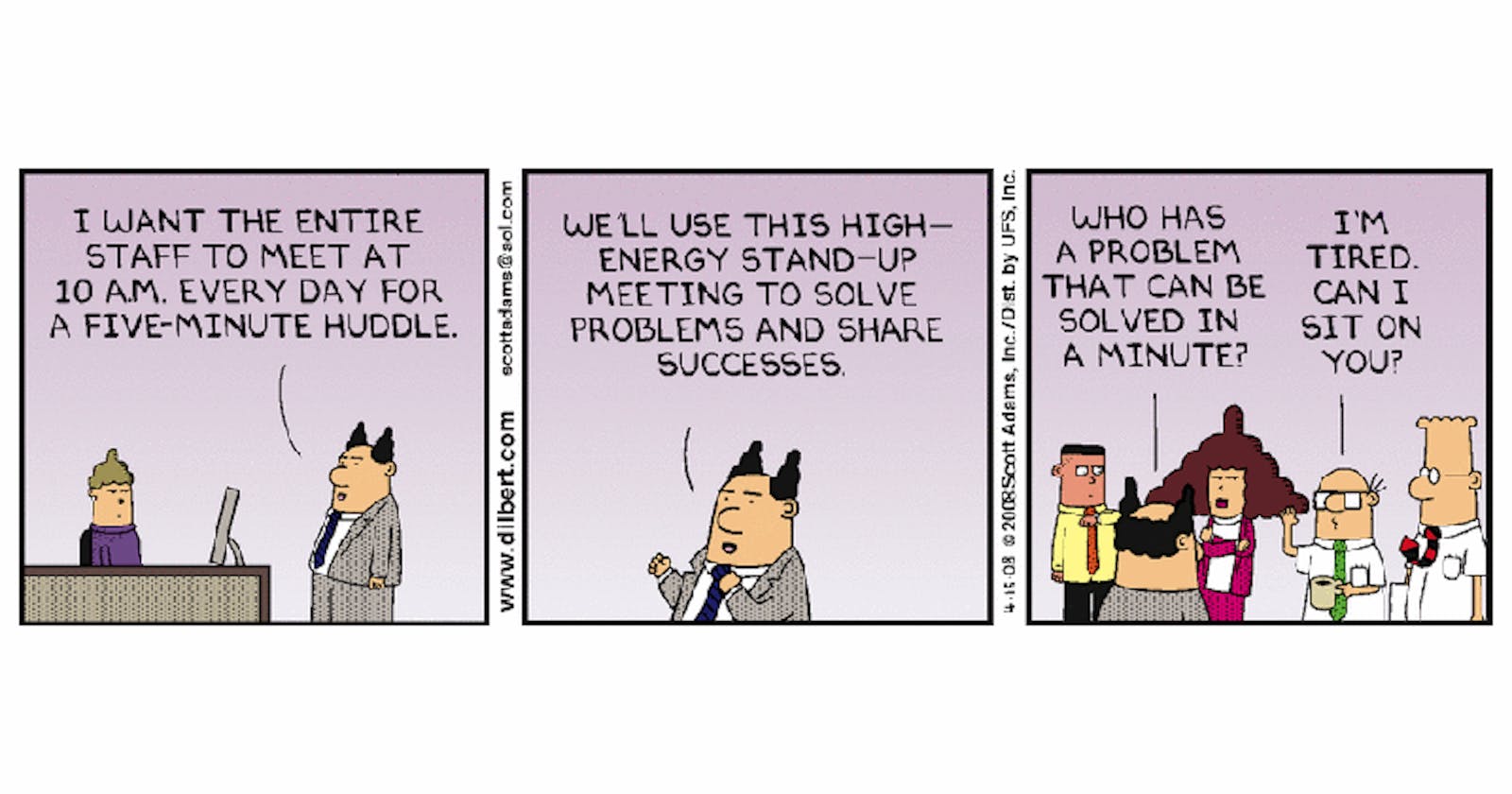In a typical project meeting most attendees do not contribute, but attend just to hear the conversation. A large amount of developer time is wasted. This drains resources from the project and can create a scheduling nightmare.
Communication between the entire team is the purpose of a stand up. This meeting occurs every morning to communicate problems, solutions, and promote team focus.
Standup meetings are fast, directed conversations between team members.
Definition
A stand-up meeting (or simply "stand-up") is a meeting in which attendees should participate while standing. The discomfort of standing for long periods is intended to keep these meetings short.
Sometimes the stand-up gets a bad rap. Some even argue it is an outdated practice and a waste of time. I disagree. I’ve found that this meeting style helps team work more effectively.
There are some pretty big differences between those who value scrum meetings and those who do not. And most of those have to do with how the meeting is run. When mastered, a stand-up is an invaluable tool for keeping a development team on track.
Some development methodologies envision daily commitments that allow the participants to know about potential challenges as well as to coordinate efforts to resolve difficult and time-consuming issues.
The meeting, "stand-up", is usually timeboxed to between 5 and 15 minutes. It should take place at the same time and place every working day. All team members are encouraged to attend, but the meetings are not postponed if some of the team members are not present.
One of the crucial features is that the meeting is a communication opportunity among team members; not a status update to management or stakeholders. Although it is sometimes referred to as a type of status meeting, the structure of the meeting is meant to promote follow-up conversation, as well as to identify issues before they become too problematic.
Team members take turns speaking, sometimes passing along a token to indicate the current person allowed to speak. Each member talks about:
- Progress since the last stand-up.
- Anticipated work until the next stand-up.
- Any impediments, taking the opportunity to ask for help or collaborate.
Team members may sometimes ask for short clarifications and make brief statements, such as "Let's talk about this offline", but the stand-up should very rarely consist of full-fledged discussions.
They are a mechanism to regularly synchronize so that teams ...
- Share understanding of goals. Understandings drifts, as does the context. A "team" where each member is working toward different goals tends to be ineffective.
- Coordinate efforts. Poor coordination amongst team members tends to lead to poor outcomes.
- Share problems and improvements. One of the primary benefits of a team versus working alone, is that team members can help each other when someone encounters a problem or discovers a better way of doing something.
- Identify as a team. It is very difficult to psychologically identify with a group if you do not regularly engage with the group.
The Questions
Scrum-Style Stand-Ups
These convene daily to coordinate development that is in progress. Though it may not be practical or prudent to limit all discussion to these three questions, the objective is to create a new sprint plan within the time box (less than 15 minutes), while deferring discussions about impediments until after the event is complete.
Team members briefly (a maximum of one minute per team member) address three questions as input to this planning:
- What did I do yesterday that helped the development team meet the sprint goal?
- What will I do today to help the development team meet the sprint goal?
- Do I see any impediment that prevents me or the development team from meeting the sprint goal?
Kanban-Style Stand-Ups
Here, the daily stand-ups focus more on:
- What obstacles are impeding my progress?
- (looking at the board from right to left) What has progressed?
Meet Where Work Happens
The workplace has many memory triggers about what is going on.
We do not want the daily meeting to require a lot of overhead coordinating, finding, and walking to rooms.
Therefore, meet where the work happens, not in a meeting room. If there is a “story wall” or “Kanban board”, meet in front of that.
Take It Offline
Some people want to engage in problem solving immediately after hearing about an issue. It is important to acknowledge that further discussion will be required to solve the raised problem. Some people may find it uncomfortable to enforce the structure of the stand-up by interrupting.
Therefore, use a simple and consistent phrase like, "Let's Take It Offline" as a reminder that such discussions should take place outside of the daily stand-up.
General Tips
- Keep It Short
- Meet Every Day
- Use A Standard Template
- Don't Allow The Conversation To Drift
- Everyone Gets A Turn
- Meet At The Same Time Every Day
- Have A Designated Meeting Leader
- You Don't Have To Actually Stand Up
Image
DILBERT © Scott Adams. Used By permission of ANDREWS MCMEEL SYNDICATION. All rights reserved.

